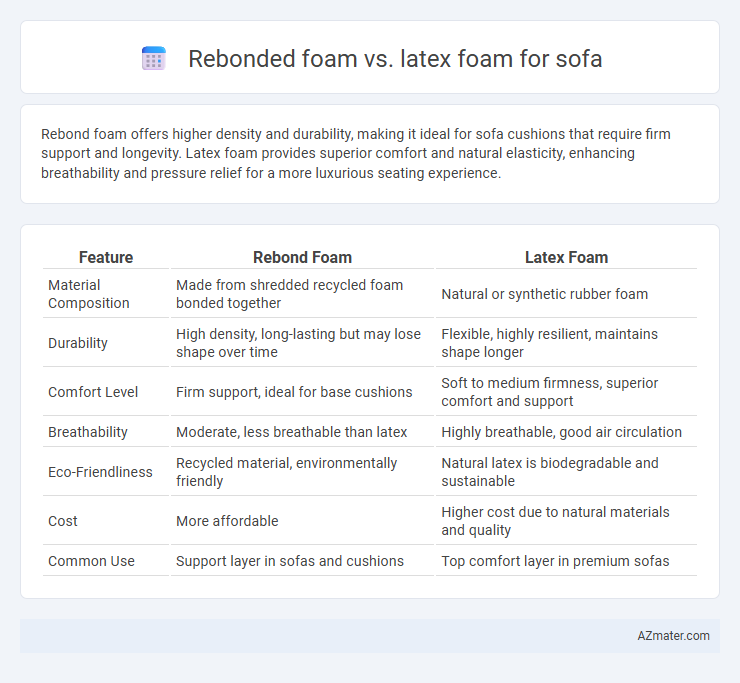Rebond foam offers higher density and durability, making it ideal for sofa cushions that require firm support and longevity. Latex foam provides superior comfort and natural elasticity, enhancing breathability and pressure relief for a more luxurious seating experience.
Table of Comparison
| Feature | Rebond Foam | Latex Foam |
|---|---|---|
| Material Composition | Made from shredded recycled foam bonded together | Natural or synthetic rubber foam |
| Durability | High density, long-lasting but may lose shape over time | Flexible, highly resilient, maintains shape longer |
| Comfort Level | Firm support, ideal for base cushions | Soft to medium firmness, superior comfort and support |
| Breathability | Moderate, less breathable than latex | Highly breathable, good air circulation |
| Eco-Friendliness | Recycled material, environmentally friendly | Natural latex is biodegradable and sustainable |
| Cost | More affordable | Higher cost due to natural materials and quality |
| Common Use | Support layer in sofas and cushions | Top comfort layer in premium sofas |
Introduction to Sofa Foam Types
Rebond foam offers high density and durability, making it ideal for firm sofa cushions with excellent support and resilience. Latex foam provides natural elasticity and breathability, ensuring comfort with pressure relief and hypoallergenic properties. Both materials serve distinct purposes in sofa construction, balancing firmness and softness to enhance seating experience.
What is Rebond Foam?
Rebond foam is a type of high-density polyurethane foam made by shredding and fusing scrap foam pieces, offering excellent durability and firmness ideal for sofa cushions. It provides strong support and maintains shape longer compared to traditional foam, making it a cost-effective choice for heavy-use furniture. Unlike latex foam, which is naturally resilient and hypoallergenic, rebond foam emphasizes durability and affordability without natural material benefits.
What is Latex Foam?
Latex foam is a natural or synthetic material derived from the sap of rubber trees, known for its elasticity, durability, and breathability. It offers excellent support and pressure relief, making it ideal for sofa cushions that maintain shape over time. Compared to rebond foam, latex foam provides superior resilience and hypoallergenic properties, enhancing comfort and longevity.
Comfort Comparison: Rebond vs Latex Foam
Rebond foam offers firm support and durability, making it ideal for heavy use and maintaining shape over time in sofa cushions. Latex foam provides superior comfort with its natural elasticity and breathability, contouring to the body's shape for enhanced pressure relief and reduced heat retention. While rebond foam excels in resilience and cost-effectiveness, latex foam is preferred for its plush feel and hypoallergenic properties, delivering a softer, more comfortable seating experience.
Durability and Longevity
Rebond foam offers high durability due to its dense composition of recycled foam scraps bonded together, making it resistant to sagging and wear in sofa cushions. Latex foam provides superior longevity with its natural elasticity and resilience, retaining shape and comfort over years without significant degradation. Both materials deliver long-lasting support, but latex foam typically outperforms rebond foam in maintaining consistent cushioning and durability in high-use sofas.
Support and Ergonomics
Rebond foam offers superior support due to its dense structure, making it ideal for maintaining sofa shape and providing firm seating comfort. Latex foam excels in ergonomics with its natural elasticity and pressure-relieving properties, promoting better spinal alignment and reducing fatigue during prolonged sitting. Both materials contribute to enhanced durability, but latex foam typically provides a more responsive and contouring support experience.
Allergen and Health Considerations
Rebond foam, made from shredded scrap foam bonded together, can harbor dust mites and allergens if not properly treated, potentially causing respiratory issues. Latex foam, naturally hypoallergenic and resistant to dust mites, mold, and bacteria, offers a healthier option for individuals with allergies or asthma. Choosing natural latex over synthetic variants enhances air quality and minimizes exposure to harmful chemicals in sofas.
Environmental Impact
Rebond foam is primarily made from recycled polyurethane foam, reducing waste by repurposing scrap materials, but it may contain chemical adhesives that can off-gas volatile organic compounds (VOCs). Latex foam, especially natural latex derived from rubber tree sap, offers a more sustainable option due to its biodegradability and renewable source, with minimal chemical processing compared to synthetic foams. The environmental impact of latex foam is generally lower, promoting better indoor air quality and reduced landfill waste over rebond foam.
Price and Value Analysis
Rebond foam generally offers a more affordable price point compared to latex foam, making it a cost-effective option for sofa cushioning without compromising basic comfort and durability. Latex foam, while more expensive, provides superior resilience, natural hypoallergenic properties, and longer lifespan, delivering greater overall value for consumers seeking premium quality. Analyzing price against durability and comfort, rebond foam suits budget-conscious buyers, whereas latex foam represents an investment in enhanced comfort and longevity.
Which Foam is Best for Your Sofa?
Rebond foam offers high durability and firm support, making it ideal for heavy-use sofas and budget-conscious buyers. Latex foam provides superior comfort with excellent elasticity, breathability, and natural hypoallergenic properties, suited for those seeking plush seating and long-term health benefits. Choosing the best foam depends on your preference for firmness, longevity, and comfort, as rebond foam excels in resilience, while latex foam excels in softness and breathability.

Infographic: Rebond foam vs Latex foam for Sofa
 azmater.com
azmater.com